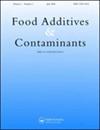摩洛哥市场上销售的传统和工业蜂蜜中的农药残留及潜在健康风险。
IF 2.5
3区 农林科学
Q2 CHEMISTRY, APPLIED
Food additives & contaminants. Part B, Surveillance
Pub Date : 2024-09-01
Epub Date: 2024-06-04
DOI:10.1080/19393210.2024.2362981
引用次数: 0
摘要
这项研究评估了摩洛哥所有 12 个地区的 44 个蜂蜜样品中是否含有甲霜灵(MET)、多菌灵(CBZ)和乙基毒死蜱(CPE)这三种农药以及 CPE 的降解产物(3,5,6-三氯-2-吡啶醇;TCP)。采用经过验证的 HPLC-UV 方法,即使 MET、CBZ、CPE 和 TCP 的浓度高于最大残留限量,其出现频率也分别为 63.6%、54.5%、95.1% 和 34.1%。根据主要农药,主成分分析将采样区域分为三组。风险评估表明,蜂蜜中这些农药的单独或混合摄入不会对消费者造成风险(HQ 和 HI本文章由计算机程序翻译,如有差异,请以英文原文为准。
Pesticide residues in traditional and industrial honey marketed in Morocco and potential health risk.
This study evaluated the presence of the three pesticides methomyl (MET), carbendazim (CBZ) and chlorpyrifos-ethyl (CPE), as well as the degradation product of CPE (3,5,6-trichloro-2-pyridinol; TCP), in 44 honey samples from all 12 regions of Morocco. With a validated HPLC-UV method occurrence frequencies of 63.6% for MET, 54.5% for CBZ, 95.1% for CPE and 34.1% for TCP were obtained, even at concentrations higher than the maximum residue limits for MET, CPE and TCP. Based on the predominant pesticide, principal component analysis separated sampling regions into three groups. Risk assessment indicated that ingestion of these pesticides, alone or in combination, in honey did not pose a risk to consumers (HQ and HI < 1).
求助全文
通过发布文献求助,成功后即可免费获取论文全文。
去求助
来源期刊
CiteScore
5.30
自引率
10.30%
发文量
37
审稿时长
2.7 months
期刊介绍:
Food Additives & Contaminants: Part B publishes surveillance data indicating the presence and levels of occurrence of designated food additives, residues and contaminants in foods, food supplements and animal feed. Data using validated methods must meet stipulated quality standards to be acceptable and must be presented in a prescribed format for subsequent data-handling.
Food Additives & Contaminants: Part B restricts its scope to include certain classes of food additives, residues and contaminants. This is based on a goal of covering those areas where there is a need to record surveillance data for the purposes of exposure and risk assessment.
The scope is initially restricted to:
Additives - food colours, artificial sweeteners, and preservatives;
Residues – veterinary drug and pesticide residues;
Contaminants – metals, mycotoxins, phycotoxins, plant toxins, nitrate/nitrite, PCDDs/PCFDs, PCBs, PAHs, acrylamide, 3-MPCD and contaminants derived from food packaging.
Readership: The readership includes scientists involved in all aspects of food safety and quality and particularly those involved in monitoring human exposure to chemicals from the diet.
Papers reporting surveillance data in areas other than the above should be submitted to Part A . The scope of Part B will be expanded from time-to-time to ensure inclusion of new areas of concern.

 求助内容:
求助内容: 应助结果提醒方式:
应助结果提醒方式:


